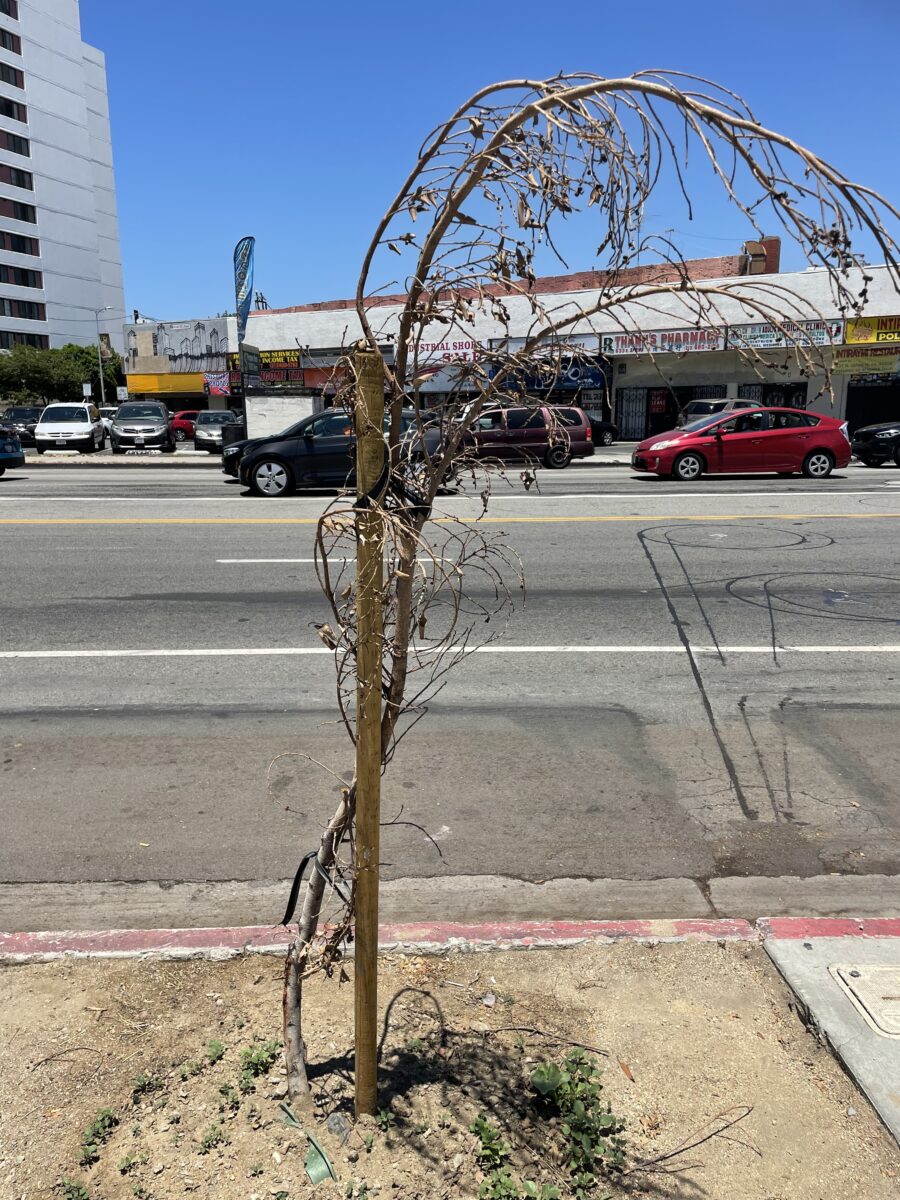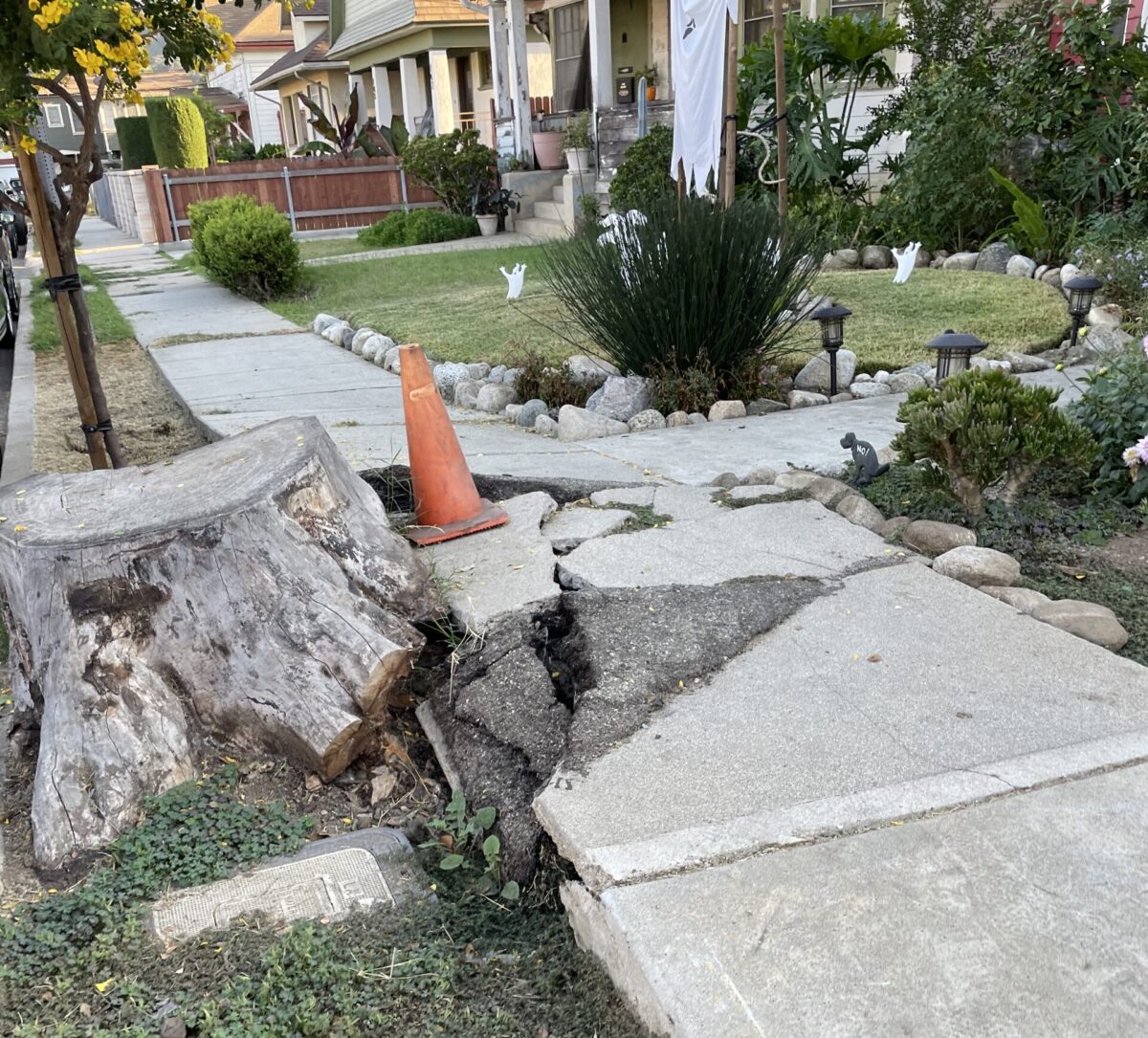Organized abandonment.
That’s a concept from scholar Ruth Wilson Gilmore, and it’s how we described the City of LA’s approach to sidewalks when talking with Los Angeles Times columnist Steve Lopez. He dove head first into the rabbit hole of LA sidewalk “policy,” and his two recent columns are worth the read (from September 1 and from August 17). He visibly captures the topography of LA sidewalks: “sidewalk mountain ranges,” “peaks and valleys,” “ramps and canyons,” “jagged peaks and snaking tree roots.”
Los Angeles has a sidewalk maintenance policy known as “Fix-and-Release.” It was intended to function like this: the City would fix the buckled sidewalk in front of your house, then release it to you—meaning, you would then be responsible for keeping the sidewalk accessible and functional. But the City is still the party with ultimate responsibility and liability (see pages 39-40 of the report) if there’s an injury from someone tripping on a broken sidewalk.
This policy has been confusing from the start. The City hasn’t made significant progress, so there’s not much to “release.” As of June 2021, only 4,879 certificates had been issued under the Fix-and-Release policy, covering less than 1% of the City’s 640,000 sidewalk parcels.
A closer look reveals that this approach is fundamentally flawed and ineffective.
As documented in an August 2023 memo from the Bureau of Engineering (BOE), the current policy assigns property owners responsibility for sidewalk maintenance under state law. At the same time, the City is tasked with ensuring accessibility under federal law. The Fix-and-Release policy, however, has resulted in the City neither fixing its sidewalk at a reasonable pace nor holding property owners accountable for their maintenance responsibilities, leaving a significant gap in this framework.
While billed as a way to equitably share responsibility between the City and property owners, Fix-and-Release is actually a policy of inaction. The City Council wrote into the municipal code that the City will not inspect and enforce maintenance obligations for any sidewalk built prior to 2017—in other words, almost every sidewalk—until the City rebuilds the sidewalk in front of that property to current accessibility standards. Theoretically, this should streamline repairs and ensure that sidewalks meet federal accessibility standards. In practice, it has done little to address the underlying issues.
The City Council’s decision to ease the burden on property owners did not fully acknowledge the significant investment required to address our sidewalk infrastructure. Nearly a decade after the City settled the Willits case, Los Angeles still does not have a complete inventory and assessment of our broken sidewalks, let alone a true accounting of how much funding it will take to fix them. This results in a systemic failure to achieve the accessibility goals the policy aims to support.
With the Council declining to enforce sidewalk maintenance, while also not developing a comprehensive plan to fix them, sidewalks remain in disrepair. The current approach is not only inadequate but also disingenuous. It allows the City to avoid taking decisive action while placing an undue burden on property owners who want accessible sidewalks in front of their homes. The “Fix-and-Release” model has proven to be a hollow promise, failing to deliver on its objectives and contributing to growing frustration among neighbors and advocates alike.
It is time for the City of Los Angeles to reconsider its ineffective sidewalk policy. For years, Investing in Place has advocated for ending LA’s Fix-and-Release model in favor of a more effective approach that genuinely improves sidewalks, enhances accessibility, and treats them as assets to be managed. We will explore these issues at our Sidewalks Zoom Workshop on September 24th, where we’ll review policies from 30 major U.S. cities. Last year, Councilmember and Public Works Committee Chair John Lee supported reconsidering Fix-and-Release, but the proposal failed to gain traction with other council members.
It’s crucial that we advocate and adopt a policy that not only promises but delivers meaningful improvements to our public spaces. Our sidewalks are not just pathways; they are vital components of our public infrastructure and essential to the well-being of all Angelenos.
In the next post, we’ll explore why sidewalks are ecosystems, and why LA’s fragmented approach to managing them is a social and environmental failure.










You must be logged in to post a comment.